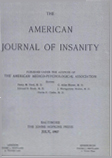Abstract
The writer has attempted to describe the symptoms of the insulin effect and their relationship to the time and the dose. Striving to apply pathological experiences for clinical purposes, it is necessary to adapt them for pharmacological use. We are accustomed to have pharmacological advice upon the administration of a treatment in figures referring to the doses of the applied drug. But in our special case, individual susceptibility, sensitization and many other factors do not permit us to use the common approach of pharmacological research. Moreover, it is likely that it is not the insulin dose or its effect on the blood sugar level which is important, but rather the effect upon the brain has to be considered as the therapeutic agent. Hence, this effect has to be adjusted pharmacologically for practical use. Norms of treatment should be created, therapeutic factors clarified, and proper indications for the management of the shock evolved. In this way only can misuse of the large insulin doses be met and a planless administration of insulin transformed to an efficient therapeutic instrument.
A complete fulfillment of these postulates belongs for the time being to the realm of scientific dreams. There are many unknown factors: individual susceptibility, sensitization, constitutional and acquired dispositions of the nervous system, individual endocrine balance, differences of metabolic response to hypoglycemia, including the reaction of the liver and the pancreas and of the muscles. No pathology of schizophrenia is known; therefore, no way is open to explain the therapeutic effect of insulin.
Though rules can be established for the application of the treatment, these rules are entirely empirical. They can be tested only in the light of the observed results and for this reason they must be followed very carefully. Analyses of failures have shown that mistaken and apparently meaningless deviations from the rules of the Clinic in Vienna were to blame for many poor results.
In the light of this clinical investigation, the "depth" of the shock can be clearly defined and exactly determined at any stage of the progression of the insulin effect by means of neurological examination. The syndromes actually present not only indicate the degree of progression but also the magnitude of the suppressed area of the brain. While hyperkinetic syndrome is present the functions of cortex are suppressed. The presence of medullary syndromes, however, indicates that the cortex, basal ganglia and midbrain are inhibited. The expression "greatest depth" is limited now to the presence of the fully developed parasympathetic medullary phase and to the decline of sensitivity (lack of corneal reflex). The shock must be terminated when these signs appear.
The time required for the insulin effect to reach the medullary phase depends upon the size of the dose. If (relatively) large doses are used the entire cycle can be run in three hours. Smaller doses produce the same effect in six or seven hours. Too great doses have the disadvantage of precipitating the shock while too small doses often are followed by spontaneous awakening. Practical experience showed that the most convenient time for a proper development of the shock is five hours. Therefore, it is proposed to choose the dose in such a way that the medullary symptoms appear in the last half of the fifth hour. The dose necessary to produce this effect must be determined daily by analyzing the charts of the preceding insulin day. If the medullary phase appeared too early (e. g., in the fourth hour) the dose must be diminished; if the medullary phase was not reached at all, the dose should be increased. Moreover, the trend of the sensitization must be taken into consideration. If increase of the sensitization is observed, the same dose may produce a deeper shock the next day, while decrease of sensitization requires an additional amount of insulin to cover it in order to produce the same effect as the day before. It must be stressed that the exact management of insulin shock is possible only if the progression of symptoms is properly recorded.
Clinical experience teaches that a great depth should be reached in order to obtain beneficial therapeutic results. The writer had the opportunity to observe that low doses and, consequently, termination in the hyperkinetic phase were often to blame for poor results. It appears, therefore, that shocks in which only the hyperkinetic phase was developed within the five hours of duration of the insulin effect must be considered as therapeutically insufficient. The writer treated 129 cases with the above described method. The medullary phase was reached in only 34.1 per cent. Nevertheless his results in treatment of recent cases are classed among the best (74.4 per cent of recovery). It must be concluded, therefore, that for recent cases those shocks are therapeutically sufficient in which the tonic phase persisted no less than one hour before termination provided by the standard of five hours.
Cline and Rossman claim relatively better results in old cases, when the medullary phase is carried to the border of the appearance of pin-point pupils and sluggishness or disappearance of the corneal reflex. For the time-being we have, therefore, two different rules, the first applied to recent cases, the other to the old ones. For recent cases it may be sufficient to reach the beginning of the medullary phase shortly before termination, while in old cases the shock has to be carried through the medullary phase to the border of the protracted shock. Such treatment of old cases requires, of course, a great deal of experience.

